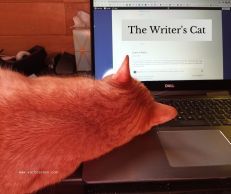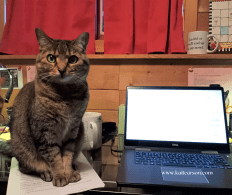The Way You Do the Thing You Do

My first reader – Cub
Happy New Year to all. Hard to believe we are saying goodbye to 2023 and looking forward to the adventures that 2024 holds in store. This is my favorite time of the year. I admit, I’m a proponent of Marie Kondo. I love clearing out the old to make way for the new. Same goes for goal setting and planning.
When you’re a writer, goal setting includes an element of hope and luck. It takes a while to write a book. The time varies by writer, and by book. A new book with new characters can take up to a year. A deep edit of an existing manuscript, three to six months. This year, I’m planning two new books and two re-releases. Ambitious. Maybe. But I have a plan.
I was one of several authors invited to a Zoom book club meeting. After the book discussions, the moderator opened the floor to general questions. Rather than further discussion of the books, the questions veered to how we write. Who knew there would be so much interest in how we make the sausage?
I admit I’ve developed an arsenal of writer’s aids over the years. None are a substitute for research and words on the page, and none make use of the buzzword of 2023 – AI. Nope, I’m an old-fashioned writer. Curiosity, plot, plan, write, edit, despair, consider dumping the lot, revise, polish, joy. And I’ve a writer’s aid for each segment.
Every story starts with a “what if” question. There’s no substitute for that. For No Return, the first Maine Mystery, I wanted to explore Maine’s porous border and the effect on Northwoods locals. Not very exciting, but toss in a long vacant guest lodge, a body in a pottery studio, a rekindled romance, and the economic engine of tourism, and bits and pieces fall into place. So, how to take that from idea to page?
Plot comes first. For this I use Plottr. There are a million ways to plot a book. Among them, the three-act structure, the four-act structure, Save the Cat, and my favorite, Story Engines. Plug one into the program, and a visual timeline appears. The program is customizable, but I find one sentence at each plot point is enough to tell me if the story has what it takes to hold my interest, and ultimately, a reader’s interest.
Once the plot is in place, it moves to Scrivener. This is where the writing takes place. It’s another visual program. I use it to write each scene and chapter on separate “cards” and keep track of characters, settings, and plot points. I can move the scene cards around at will as the needs of the story change and grow. Best of all, it interfaces with Word and allows me to keep track of multiple versions during and after edits. Of course, Cub is very helpful at this stage of the process.

Piper – my editor and harshest critic
Editing is as close to AI as I get. My weapon of choice is ProWritingAid and I use it for grammar and comma (the bane of my writing existence) assistance. It’s invaluable at identifying misused words and spelling errors. Some of my errors are laugh out loud funny and the program has saved me from a case of chronic red-face. I save my edited work to Scrivener and then export it to Word who reads to me. It’s amazing what the ear hears that the eyes miss. Then it’s off to beta readers and ready for prime time. Piper has the final word on whether it’s ready to go. Clearly, she thought this story needed more work.
That’s my recipe for sausage. Remarkable how similar it is to other authors. Much different to the early days.
Lea Wait's Blog
- Lea Wait's profile
- 509 followers



